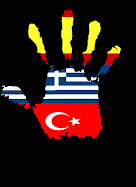(basada en la novela del escritor griego Dimitris Siatíopulos El pintor de Dios)
Acabamos de llegar de nuestro viaje a Estambul y Atenas y, como si los hados se hubieran puesto de acuerdo para que no nos olvidemos de nuestra reciente experiencia en Grecia, nos encontramos con los carteles publicitarios de una película épica sobre El Greco, atormentado pintor nacido en la isla de Creta, de formación en la escuela veneciana, y asentado en su madurez en España, donde hizo grande el arte de la pintura de tema religioso. Sus creaciones, como las de los grandes artistas, hacen que los extremos se toquen: materialismo y espiritualidad. Sus personajes reflejan virtudes y defectos humanos y, sin embargo, destilan ascetismo y nos acercan a lo divino. Pintor incomprendido en su época, como todos los genios, con el tiempo se convirtió en referente no sólo para otros pintores, sino también para los escritores de la generación del 98.
En nuestra opinión, a la película le falta acción, debido a su narración en forma de diario en primera persona. Pero posee otros logros como el espectacular trabajo de los dos antagonistas, El Greco y el cardenal Niño de Guevara (Nick Ashdon y Juan Diego Botto), en el eterno enfrentamiento entre la gracia divina y la vulgaridad.
Recomendable documento didáctico para estudiar la época del Barroco con sus claroscuros: esplendor artístico frente a la repudiable actuación de la Inquisición. Aunque nosotros nos quedamos con las imágenes costumbristas de la isla de Creta, la música de Vangelis, las danzas populares y el rakí…¡Qué gratos recuerdos!
(based on the novel God`s Painter by the Greek writer Dimitris Siatíopulos)
Just after returning from our trip to Istambul and Athens as if Fate had agreed not to allow us forget our recent experience in Greece, we came across the posters showing the epic film “El Greco” at our local cinemas. He was a tormented painter born in the island of Crete, from the Venecian school, who spent his adult life in Spain where he mastered the religious genre. His creations, as the greatest artists’ ones, entangled extreme considerations such as: materialism and spirituality. His characters reflect human virtues as well as vices. They both show asceticism and appproach us to the divine. He was misunderstood in his lifetime, as geniuses always are but, as time passed, he became an idol for other painters and for the writers of the 98 generation.
In our opinion, the film lacks action since it is presented in the form of a diary written in the 1st person; but the two main characters , The Greco (Nick Ashdon), and Cardinal Niño de Guevara (Juan Diego Botto) make an spectacular work, enhancing the eternal clash between divine grace and vulgarity.
It is undoubtedly a recommendable didactic document to study the Barroque period and its chiaroscuro: artistic splendour versus the revolting methods of the Inquisition.
To end up, we would want to suggest a less dramatic insight, to enjoy the strong regional flavour of Crete’s customs and manners, the music by Vangelis, the popular dances, the raki... What nice remembrances!
















 Ahmet Çallioglu Çok Programli Lisesi (Aydin, Turkey)
Ahmet Çallioglu Çok Programli Lisesi (Aydin, Turkey)
 Primary School of Afxentio (Xanthi, Greece)
Primary School of Afxentio (Xanthi, Greece)
 I.E.S. Monastil
I.E.S. Monastil


